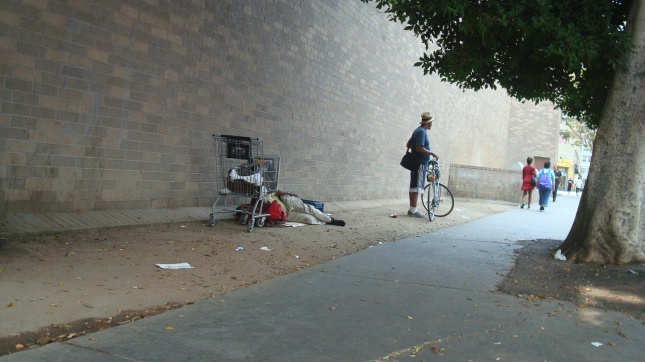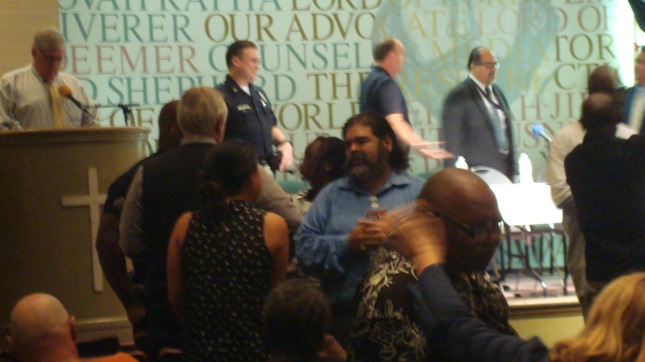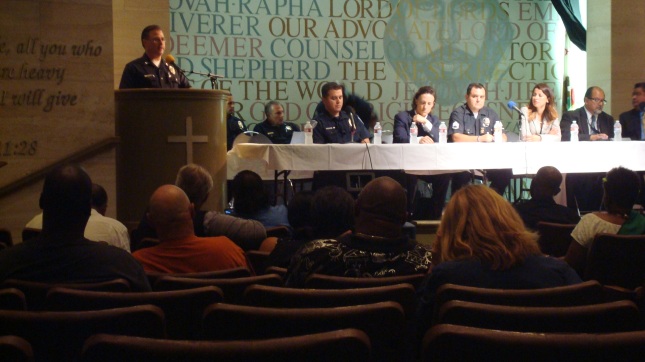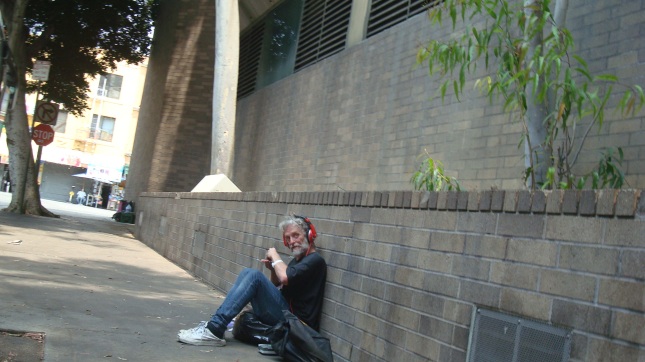
Toward the end of July there was a meeting at the Union Rescue Mission regarding the Safer Cities Initiative. I’d like to stop here for a minute and ask you to think about that phrase.
The Safer Cities Inititiative.
Of course, if you take the words at face value, who wouldn’t support it? We all want safer cities. So if our Mayor and City Council tell us they’re taking action to reduce the crime and the grime in Downtown, how could anyone argue against them. But, as is so often the case, the phrase was created to be blandly reassuring. It’s meant to make people feel good, even if a lot of the people most directly affected don’t feel good about it at all.
I don’t pretend to be an expert on the homeless problem in Downtown LA. It’s a messy, complicated situation. But what follows is a brief summary of how we got to this point, at least as I understand it….
Back in the seventies it was decided that the best way to deal with the homeless in LA would be to corral them all into one area, away from the financial district and the city government buildings. Local leaders had ambitious plans for the central city, and it doesn’t look good to have a guy who hasn’t bathed for a week sleeping on the street next to your shiny new skyscraper. So with the homeless now out of sight, they were also out of mind, and everybody thought the problem was solved.
Then in the eighties LA’s manufacturing base suddenly disappeared, and the illegal drug trade started ramping up. All of a sudden there was a whole new wave of people flooding Skid Row, and instead of docile winos you had guys strung out on crack and PCP. The fact that AIDS and hepatitis were also on the rise made the situation even more dire. But most of us didn’t worry too much about it. A lot of people living in the Valley couldn’t understand why anybody would even consider going to Downtown. The same applied to many west side residents. Successive city government regimes kept pouring money into the financial district, and kept hoping the homeless would just go away. The vast majority of Angelenos paid no attention at all.
Then, maybe ten or fifteen years ago, things started to change. Slowly the perception of Downtown started to shift. Younger Angelenos began to see the benefits of living in a place where art and music and bars and restaurants were all within walking distance. And the city government managed to lure a growing number of businesses to the area. Something like a renaissance was taking shape, and gradually Downtown became the cool place to be.
That was the upside. Unfortunately, in the middle of this renaissance, there were still all these homeless people hanging around. The business owners and some of the newer Downtown residents were freaking out, sometimes with good reason, over the problems created by having a huge number of people, some drug users, some mentally ill, living on the streets.
And this is where the Safer Cities Initiative comes in. Back in 2007, Mayor Villaraigosa and Chief Bratton decided to adopt a zero tolerance approach to crime in Skid Row. Even small offenses resulted in an arrest, with the possibility of time in jail. On top of that, the LAPD was charged with conducting regular sweeps of the area to clear away anything that was blocking the sidewalks, i.e. shopping carts, tents, boxes, etc.. Among other problems with this approach, they ended up trashing property belonging to homeless individuals, including personal documents and prescription medication. A suit was filed to stop the sweeps, and a judge agreed with the plaintiff, putting an end to the practice. For a while.
This put the city back at square one. How to deal with the impacts caused by thousands of people who have nowhere to go except the streets of Skid Row? At this point, the LA County Department of Health stepped in. They conducted an investigation and produced a harrowing report that documented the many health problems in the area, like rats, used hypodermic needles and human waste. This gave the city the justification they needed to start in with the sweeps again.
Which brings us up to the present, and back to the meeting at the Union Rescue Mission….
While they’re still calling it the Safer Cities Initiative, officials have tweaked the program in the hope of making it more effective. Now the LAPD will issue citations for minor violations instead of arresting people. The sweeps will resume, as part of the Operation Healthy Streets program, but now case workers and mental health professionals will accompany the cleaning crews. The word is that the homeless will be offered free medical exams and TB tests, and an effort will be made to get people into detox or enroll in a health care program under the Affordable Care Act.
This sounds good on paper. The city officials who were on the panel at the meeting tried to keep it positive, though a woman from Jose Huizar’s office downplayed the modifications to the street cleaning program. She emphasized the fact that this was something the City was trying out, and that it wasn’t intended to be a solution to the homeless problem.
It’s not a solution. While this approach is better than what the City was doing before, it’s basically a band-aid, and the situation on Skid Row is not getting better. It’s getting worse. In recent years the State of California has been forced to release thousands of inmates from its prisons. It’s a real challenge for someone with a criminal record to find steady work, which also makes it hard to find a permanent place to stay. So a lot of those people who were pushed out of the prisons ended up on Skid Row. The non-profits who serve the homeless, like Union Rescue Mission, have been struggling for years. Now they’re completely overwhelmed.
The City needs to make a serious effort to provide permanent supportive housing for the homeless. Yes, this would cost money, and we’re still operating on a tight budget, but we could get the ball rolling. In New York, Mayor de Blasio has made a commitment to create permanent supportive housing, and we could do the same here. As expensive as this approach is, it’s still way cheaper than throwing people in jail for minor violations. We are currently spending a fortune on prison beds for non-violent offenders who would be better served by relatively inexpensive programs providing rehab and mental health care. And building permanent supportive housing would make Downtown a cleaner, safer place, creating an environment where business could thrive.
Phrases like Safer Cities Initiative and Operation Healthy Streets sound nice, but handing out tickets and clearing the streets every other month will not solve the problem. We need to stop being reactive and start being proactive. If you feel, like I do, that we could be doing more, then give your City Council rep a call and let them know.



